张奎武《英美概况》笔记及习题 (加拿大)【圣才出品】
- 格式:pdf
- 大小:898.69 KB
- 文档页数:15

第1章教育1.1 复习笔记I. A Brief Introduction to American EducationII. Elementary EducationIII. Secondary EducationIV. Higher Education—College and University1. General Introduction2. Types of Institutions3. Faculty Members4. Part-time Working and Student’s Organization V. Admission, and Academic Levels1. Admission2. Academic Levels and Academic Calendar3. CreditsVI. Graduate StudyVII. Well-known Universities in America1. Ivy League2. Harvard University3. Yale UniversityVIII. LibrariesI. A Brief Introduction to American Education (美国教育的概况)1. Education has been greatly respected throughout the history of the United States.在美国的历史进程中,教育受到了很高的重视。
2. At the turn of the twentieth century, public education developed more rapidly and more people got the opportunity of going to school.20世纪之交,公共教育发展迅速,越来越多的人得到了受教育的机会。
II. Elementary Education (初等教育)1. Many children begin their school education at the age of six and children usually graduate from high school at the age of 18.很多孩子6岁开始上学,18岁高中毕业。
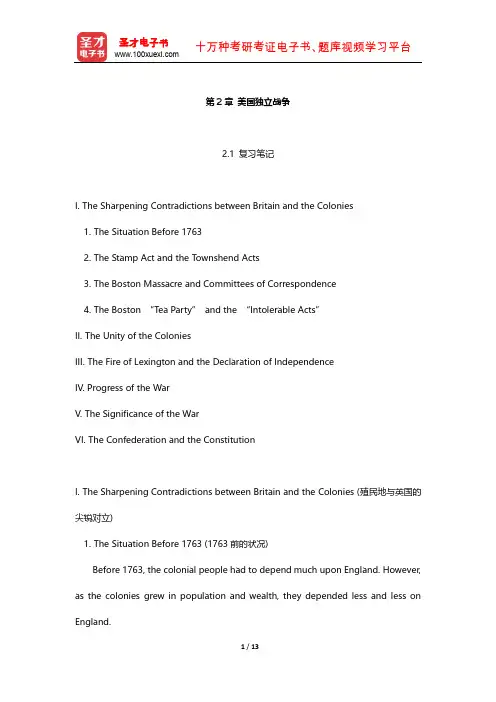
第2章美国独立战争2.1 复习笔记I. The Sharpening Contradictions between Britain and the Colonies1. The Situation Before 17632. The Stamp Act and the T ownshend Acts3. The Boston Massacre and Committees of Correspondence4. The Boston “Tea Party”and the “Intolerable Acts”II. The Unity of the ColoniesIII. The Fire of Lexington and the Declaration of IndependenceIV. Progress of the WarV. The Significance of the WarVI. The Confederation and the ConstitutionI. The Sharpening Contradictions between Britain and the Colonies (殖民地与英国的尖锐对立)1. The Situation Before 1763 (1763前的状况)Before 1763, the colonial people had to depend much upon England. However, as the colonies grew in population and wealth, they depended less and less on England.1763年前,殖民地人民非常依赖英国。
然而,随着殖民地人口和财富的增长,对英国的依赖度逐渐减少。
2. The Stamp Act and the T ownshend Acts (印花税和唐森德税法)(1) The Stamp Acta. In 1765, Stamp Act was made. According to this act stamped paper must be used for all legal documents and other articles.b. The people of the colonies rose to oppose it. Facing so much opposition both in America and in England, the Parliament had to repeal the Stamp Act in 1766.(2) Townshend Actsa. All the goods imported into the country must be taxed.b. In 1770, the T ownshend taxes were all repealed except the tax on tea.(1) 印花税a. 1765年,印花税出台。
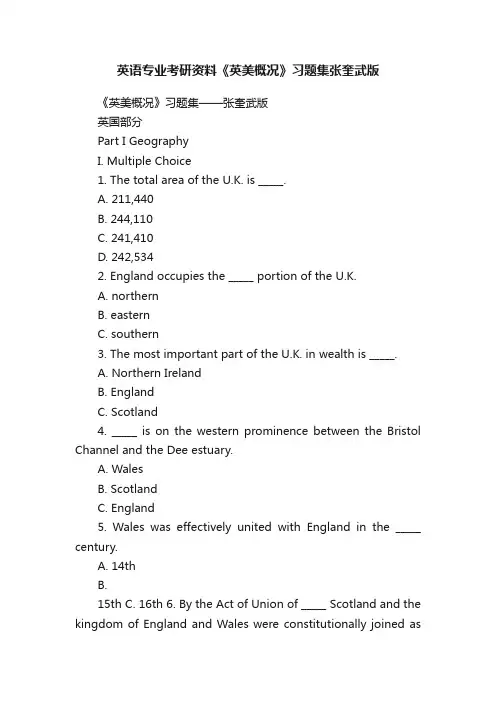
英语专业考研资料《英美概况》习题集张奎武版《英美概况》习题集——张奎武版英国部分Part I GeographyI. Multiple Choice1. The total area of the U.K. is _____.A. 211,440B. 244,110C. 241,410D. 242,5342. England occupies the _____ portion of the U.K.A. northernB. easternC. southern3. The most important part of the U.K. in wealth is _____.A. Northern IrelandB. EnglandC. Scotland4. _____ is on the western prominence between the Bristol Channel and the Dee estuary.A. WalesB. ScotlandC. England5. Wales was effectively united with England in the _____ century.A. 14thB.15th C. 16th 6. By the Act of Union of _____ Scotland and the kingdom of England and Wales were constitutionally joined asthe Kingdom of Britain.A. 1707B. 1921C. 18017. Psysiographically Britain may be divided into _____ provinces.A. 13B. 12C. 148. Mt. Ben Nevis stands in _____.A. the Scottish HighlandsB. WalesC. England9. The main rivers parting in Britain runs from _____.A. north to southB. south to northC. east to west10. Cheviot hills lie along the border between _____ and England.A. ScotlandB. WalesC. Vale of Eden11. The longest river in Britain is _____.A. SevernB. ClydeC. Bann12. London is situated on the River of _____.A. ParretB. ThamesC. Spey13. Edinburgh is the capital of _____.A. EnglandB. ScotlandC. Wales14. The rivers flowing into the _____ are mainly short.A. North SeaB. English ChannelC. Dee estuary15. Mt. Snowdon stands in _____.A. ScotlandB. WalesC. England16. The source of the important River Thames is in the _____.A. CotswoldsB. Oxford ClayC. Pennines17. About _____ of the water requirements are obtained from underground sources.A. 50%B. 38%C. 42% 更多资料尽在英语专业论坛w w w .e n g l i s h m .c n18. Gaelic is mainly spoken in _____. A. Scotland B. England C. Northern Ireland 19. The Bank of England was nationalized in _____. A. 1964 B. 1946 C. 1694 20. Britain is basically an importer of _____. A. food B. raw materials C. manufactures D. both A and B 21. British farmers produce enough food to supply _____ of the needs of the population. A. 2/3 B. 4/5 C. 1/2 22. Britain’s main cereal crop is _____. A. oats B. corn C. barley D. rye 23. The center of the Britain financial system is _____. A. Bank of England B. Bankof Britain C. Bank of U.K. 24. The three Germanic tribes that invaded Britain include the following except _____. A. the Angles B. the Saxons C. the Picts D. the Jutes 25. “Black Country” refers to _____. A. countryside in England B. an area around Birmingham C. a country in Africa 26. The second largest port in Britain is _____.A. LondonB. BelfastC. Liverpool 27. The capital city of Northern Ireland is _____. A. Cardiff B. Belfast C. Leith 28. Celtic tribes began to settle in Britain from about _____ B.C. A. 410 B. 750 C. 300 29. The U.K. is rich in the following except _____. A. coal B. iron C. goldD. tin 30. The decrease of British population is caused by the following except _____. A. limitation of immigration B. fall of the birth rate C. fall of death rate D. unemployment 31. The proportion of the English in the whole population is _____. A. 60% B. 80% C. 70% 32. The Queen’s University is in the city of _____.A. BelfastB. EdinburghC. Manchester33. The contribution made by the Normans to Britain is the following except _____.A. final unification of EnglandB. foundation of aristocracyC. great administrative progressD. some peculiarities of dialect34. About _____ percent of the population live in cities or towns.A. 80B. 85C. 9035. The land available for farming in England, Wales, Scotland and Northern Ireland does not exceed _____ million acres.A. 30B. 25C. 4036. The highest mountain in England is _____.A. Mt. MourneB. Mt. SnowdonC. Mt. Seafell37. The second largest city in England is _____. 更多资料尽在英语专业论坛w w w .e n g l i s h m .c nA. GlasgowB. BirminghamC. Manchester 38. The modern Scots and Irish are the descendants of _____. A. Gaels B. Britons C. Anglo-Saxons 39. Scotland occupies the _____ portion of Great Britain. A. southern B. northern C. western 40. By the Act of Union in _____, the name United Kingdom of Great Britain and Ireland was adopted. 41. _____ has its own national church and its own system of law. A. Wales B. Northern Ireland C. Scotland 42. The _____ End includes Westminster, St. James’ Palace A. East B. West C. North 43. _____ includes London, the centre of government for the whole nation.A. ScotlandB. Northern IrelandC. WalesD. England II. Fill in the Blanks 1. The U.K. is situated in _____ Europe. 2. The full title of the U.K. is the United Kingdom of _____ _____ and _____ _____. 3. The U.K. consists of England, _____, _____ and Northern Ireland. 4. The largest part of U.K. is _____. 5. The capital of England and of Great Britain is _____. 6. _____ _____ is composed of six Irish counties that elected to remain in the union with Great Britain. 7. The name United Kingdom of Great Britain and Ireland was replaced by the present name after the 26 counties of Ireland obtained autonomy in _____. 8. The highest mountain in Britain is _____ _____. 9. The “Backbone of England”refers to the _____. 10. Natural gas was discovered in Britain in the _____ _____. 11. The most important river is the River of _____. 12. The political centre of the Commonwealth is _____. 13. Belfast Lough and Lough Neagh lie in _____ _____. 14. The climate of Britain is moderated by the _____ _____ _____ and is much milder than that of many places in the same latitude. 15. Britain’s Industrial Revolution took place between _____ and _____.16. The Bank of England was founded in _____.17. The population of the U.K. is more than _____ million.18. Britain is basically an exporter of _____.19. The population of the U.K. consists of the English, the Welsh, the Scottish and the _____.20. In Wales many people speak _____.21. People sing the national anthem in _____.22. The earliest invasion is that by the _____-haired Mediterranean race called the Iberians.23. The modern _____ and _____ are the descendants of the Gaels of the Celtic tribes.24. The Britons of the Celtic tribes were the forefathers of the modern _____.25. Greater London is made up of 12 _____ London boroughs and _____ Outer London boroughs.26. The International festival of music and the arts is held every year in the city of _____. 更多资料尽在英语专业论坛w w w .e n g l i s h m .c n27. The British national anthem is _____ _____ _____ _____. 28. The U.K. lies to the _____ of France. 29. Westminster, the area of central government administration is situated in the _____ End. 30. River _____ flows through Glasgow. 31. Mt. Seafell stands in _____.32. The source of the River _____ is in the Cotswolds. 33. Thecapital city of Wales is _____. 34. The United Kingdom is rich in _____, iron, tin, copper, lead and silver. III. Define the Following Terms 1. “Backbone of England” 2. Greater London 3. Celts 4. The “Irish Question” IV . Answer the Following Questions 1. What are the major factors influencing the British weather characterized by a moderate temperature and plenty of rainfall?2. Why is United Kingdom said to be a trading nation?3. What are the general characteristics of the British economy? Part II History I. Multiple Choice 1. Julius Caesar invaded Britain _____. A. once B. twice C. three times 2. King Arthur was the king of _____.A. PictsB. CeltsC. ScotsD. Jutes 3. The first “King of the English” was _____. A. Alfred B. Egbert C. Bede D. Ethelred 4. Christianity was introduced into England in the late _____ century. A. 14th B. 8th C. 6th 5. In 1653 _____ was made Lord Protector for life. A. Oliver Cromwell B. Charles I C. William II 6. The three great Germanic tribes: the Anglos, the _____ and the Jutes which invaded Britain form the basis of the modern British people.A. SaxonsB. ScotsC. WelshD. Wessex7. The head of the church in Anglo-Saxon times was _____.A. the King of Denmark and NorwayB. the king of EnglandC. Julius CaesarD. the Archbishop of Canterbury8. The _____ invaded England in the earliest time.A. DanesB. IberiansC. RomansD. Celts9. The Vikings who invaded England at the turn of the 8th century came from _____.A. NorwayB. DenmarkC. FranceD. both A and B10. Edward was known as the “_____” because of his reputation for saintliness.A. ConfessorB. ConquerorC. Protector11. Norman Conquest began in _____. 更多资料尽在英语专业论坛w w w .e n g l i s h m .c nA. 1016B. 1066C. 1035 12. In history _____ was nicknamed “King of Lackland”. A. John B. Henry I C. Henry II 13. In 1181 Henry II issued the _____ which made it compulsory for every freeman in England to be provided with arms. A. Inquest of Sheriffs B. Assize of Arms C. Doomsday Book 14. Henry Plantagenet, in 1154, established the House of Angevin as _____. A. Henry I B. Henry II C. Henry III 15. Henry II appointed in 1162 _____ Archbishop of Canterbury. A. Thomas Becket B. Stephen Langton C. Simon de Mortfort 16. Charles I was beheaded in _____. A. 1649 B. 1648 C. 1653 17. It was _____ who summoned Model Parliament in 1295.A. Edward IB. Henry IVC. Simon de Montfort 18. The Great Charter contained _____ sets of provisions. A. two B. four C. three 19. The Peasants Uprising in 1381 was led by _____. A. HenryTurner B. Watt Tyler C. Richard 20. The English Church was strictly _____. A. national B. international C. regional 21. The Glorious Revolution in 1688 was in nature a _____. A. coup d’etat B. racial slaughter C. peasant rising 22. The Industrial Revolution laid a good foundation for the _____. A. factory of the world B. expansion of markets C. social upheaval 23. The American Revolution (the American War of Independence) broke out in _____ and ended in _____. A. 1775, 1783 B. 1774, 1782 C. 1786, 1784 24. The Battle of Hastings took place in _____. A. 1606 B. 1042 C. 1066 25. The Great Charter was signed by _____ in 1215.A. King Henry IIB. King RichardC. King John 26. In the early 14th century feudalism began to _____ in England. A. grow B. flourishC. declineD. end27. It was _____ who published the book “The Rights of Man”.A. Thomas MoreB. Thomas PaineC. Thomas Jefferson28. The first Prime Minister was _____.A. WilmintonB. George GrenvilleC. Robert Walpole29. The Parliament of 1265 which is known as the “_____” is considered the “beginning of parliament”.A. All Estates ParliamentB. Model ParliamentC. Long Parliament30. The Anglo-French hostility which began in 1337 and ended in 1453 was known as _____.A. the Wars of RosesB. the Hundred Years’ WarC. Peasant Uprising31. In the first half of 17th century _____ grow rapidly in England.A. feudalismB. capitalismC. Catholicism 更多资料尽在英语专业论坛w w w .e n g l i s h m .c n32. Prime Minister _____ resisted any reform that could be resisted. A. Palmerston B. Robert Peel C. Gladstone 33. By the end of the Hundred Years’ War only the port of _____ remained under English rule. A. Troyes B. Gascon C. Calais 34. In the 14th century took place the _____, the severest of many plagues in the middle ages. A. Earthquake B. Black Death C. Drought 35. _____ and his followers, known as Lollards, provided ideological preparation for the labour movement of the 14th century. A. John Wycliffe B. Watt Tyler C. Somerset 36. By the end of the Wars of the Roses the House of _____ began. A. Tudor B. Lancaster C. Plantagenet 37. In the “_____” of 1388 five lords accused the King’s friends of tre ason under a very expansive definition of crime. A. All Estates parliament B. Merciless Parliament C. Model Parliament 38. In the Wars of the Roses the Lancastrians wire badges of _____ rose. A. white B. red C. pink D. yellow 39. The first Civil War in Britain lasted from _____ to _____. A. 1600, 1604 B. 1640, 1644 C. 1642, 1646 40. William Shakespeare is mainly a _____. A. novelist B. dramatist C. poet 41. In 1689 the “Bill of Rights” was passed. _____ began in England. A. The Constitutional Monarchy B. All Estates Parliament C. House of Lancaster 42. The _____carried on trade relations with Russia and central Asian countries.A. Moscow CompanyB. Eastland CompanyC. East India Company43. _____ started the slave trade in the second part of the 16th century. A. John Hawkins B. Francis Drake C. Diaz 44. In 1534 Parliament passed the “_____”, according to which Henry VIII was declared the head of the English Church. A. the Bill of Rights B. Act of Supremacy C. Act of Settlement 45. Under Elizabeth I _____ was restored, and she was declared “governor” of the church. A. the Roman Church B. the Catholic Church C. the Anglican Church46. In 1337 the hostility between England and _____ resulted in the Hundred Years’ War.A. FranceB. SpainC. Russia47. The religious persecution mainly existed during the reign of _____.A. CromwellB. Charles IC. Henry VIII48. England first became a sea power in the time of _____.A. Henry VIIB. Elizabeth IC. Victoria49. The Industrial Revolution first started in _____.A. the iron industryB. the textile industryC. the coal industry50. From 1688 to 1783 English Parliament was mainly controlled by the party of _____.A. ToryB. WhigC. Labour51. The English Prime Minister during the Second World War was _____. 更多资料尽在英语专业论坛w w w .e n g l i s h m .c nA. ChurchillB. ChamberlainC. Baldwin 52. At the End of _____ century, the East India Company was formed. A. 15th B. 16th C. 14th 53. The Seven Years War between England and France lasted from _____ to _____. A. 1756, 1763 B. 1713, 1720 C. 1754, 1761 54. In 1689 Parliament passed “_____”, limiting the powers of the crown. A. Habeas Corpus Act B. the Bill of Rights C. Navigation Act 55. _____ contrasted the first successful steam locomotive. A. George Stephenson B. Samuel Crompton C. James Hargreaves 56. The “Peterloo Massacre” took place in _____. A. Birmingham B. Liverpool C. Manchester 57. Between 1911 and 1914 took place the following strikes except _____. A. railway strike B. strike of the postmen C. coal strikeD. strike of the transport 58. The Victorian Age was over the _____ began. A. Edwardian Age B. Georgian Age C. Elizabethan Age 59. The _____ government surrendered to the British invaders and was forced to sign the first unequal Treaty of Nanjing in 1842.A. IndianB. QingC. IrishD. Spanish 60. The Great Charter was essentially a _____. A. Culture Movement B. colonial document C. feudal document 61. _____ broke out two years after the Hundred Years’ War with France. A. The Bore War B. The Wars of the Roses C. Queen Anne s’ War 62. The Reformation was a product of _____. A. the Renaissance B. the Chartist Movement C. theHundred Years’ War 63. The greatest dramatist of the English Renaissance was _____. A. Shakespeare B. Milton C. Chaucer D. Bacon 64. The English Revolution marks the beginning of the _____ period of capitalism. A. feudal B. modern C. colonial D. medieval 65. By the _____ in 1783, Britain recognized the independence of the US. A. Declaratory Act B. Treaty of Paris C. Treaty of Montgomery 66. The Chartist Movement began in _____ and reached its height in _____. A. 1845, 1858 B. 1828, 1835 C. 1839, 184867. In 1840 Britain launched an aggressive war against _____.A. FranceB. IndiaC. ChinaD. America68. _____ formed a coalition government in 1940.A. Winston ChurchillB. Lloyd GeorgeC. Neville Chamberlain69. By the _____ the British dominions became independent states in all but name.A. Statue of WestminsterB. Locarno TreatyC. Disputes Act70. The Fabians Society was founded in 1883, including intellectuals such as _____.A. William Shakespeare & Ben JonsonB. Christopher Marlowe & John MiltonC. G . B. Shaw & H. G . Wells71. Before WWII _____ relied on appeasement of the European dictators to reduce tensions that 更多资料尽在英语专业论坛w w w .e n g l i s h m .c nmight lead to war. A. Neville Chamberlain B. Stanley Baldwin C. Winston Churchill 72. During WWII, Britain, America, France, Soviet Union and other antifascist countries formed a united international alliance which was called _____. A. Locarno Treaty B. Grand Alliance C. Statute of Westminster 73. The first coalition government during WWI was organized when _____ was the Prime Minister. A. Lloyd George B. Herbert Asquith C. Stanley Baldwin 74. When Germany invaded _____ which was neutral, Britain declared war on Germany on 4 August, 1914. A. Austria B. Russia C. Belgium D. Poland II. Fill in the Blanks 1. At about 3000 BC, some of the _____ settled in Britain. 2. About 122 AD, in order to keep back the Picts and Scots, the _____ built Hadrian’s Wall.3. The real Roman conquest began in _____.4. _____ _____’s “Paradise Lost” was published in 1667.5. Beowulf, considered the greatest Old English poem, is assigned to _____ Times.6. _____ was considered the first national hero.7. On Christmas Day 1066 Duke _____ was crowned in Westminster Abbey.8. In history John was nicknamed King of _____.9. John signed the document in 1215, which in history was called the Great Charter or _____ _____.10. In 1086 William had his official to make a general survey of the land, known as _____ Book. 11. The most famous scholar during Anglo-Saxon Times was _____. 12. The Battle of _____ paved the way for the Norman Conquest to England. 13. The Norman Conquest increased the process of _____ which had begun during the Anglo-Saxon Times. 14. Duke William was known in history as William the _____. 15. Along with the Normans came the _____ language. 16. The English parliament originated in the _____ _____.17 The head of the _____ was Archbishop of _____. 18. The _____ _____ in 1688 w as in nature a coup d’etat. 19. The People’sCharter included _____ points such as universal male suffrage.20. The corrupt Qing government surrendered to Britain and was forced to sign the first unequal Treaty of _____ in 1842.21. After the Crimean War _____ was forced not to fortify Sebastopol.22. The third collection of the poll tax in the early part of 1381 became the fuse of _____ _____ rising.23. The Wars of the Roses broke out between the _____ and the _____.24. The Enclosure Movement began in the _____ century.25. By the treaty of _____ in 1783, Britain recognized the independence of the US.26. In _____ Britain launched the Opium War against China.27. The East India Company formed at the end of the 16th century was one of _____ companies.28. After the Reformation the Roman Catholic Church was _____, the English Church was strictly 更多资料尽在英语专业论坛w w w .e n g l i s h m .c n_____. 29. Mary I re-established Catholicism and burnt three hundred Protestants, for which she was called “_____” Mary. 30.“Renaissance” means “_____”, i.e. Europe rediscovering its origins in the cultures of ancient Greek and Rome. 31. During the Renaissance, the thinkers who worked for freedom and enlightenment were called “_____”. 32. The nature of the Wars of the Roses was a _____ _____ war. 33. By the beginning of the Tudor reign the manor system was replaced by the _____ system.34. In the summer of 1588 the Spanish ships, the _____ _____ was defeated by English ships. 35. The greatest English humanist was Sir _____ _____ whose work _____ became a humanistic classic in the world literature. 36. English Renaissance began in _____century. 37. The House of _____ was notorious for its absolutist rule. 38. During the Civil Wars (1642 – 1648) the supporters of Parliament were called _____ while the supporters of the King Charles I were called _____. 39. In 1653 Cromwell was made _____ _____ for life and started his military dictatorship openly. 40. The Seven Years War was ended by the Treaty of _____. 41. The first two parties appeared in England were the _____ and the _____. 42. The basic point of the People’s Charter is _____ _____. 43. In 1764 James Hargreaves invented the _____ _____. 44. From 1863 to the end of the century Britain had been carrying a foreign policy of _____ _____. 45. The Parliament passed the Act of _____ in 1701, excluding James Catholic son from the succession. 46. After Charles I was beheaded in 1649 England was declared a _____. 47. In September 1939 Germany invaded _____, thus Britain and France declared war on Germany. 48. The Industrial Revolution started during the last part of the _____ century. 49. The steam engine was invented by _____ _____ in 1769. 50. Samuel Crompton invented the _____ _____ in 1779. 51. Edmund Cartwright invented the _____ _____ in 1785. 52. Upon the completion of the _____ _____ by 1850 England became the workshop of the world.53. In 1868 the first Trade Union Congress met in _____.54. In 1534 Parliament passed the “_____ _____ _____”.55. On the eve of WWI the Triple Alliance between Germany, Austria-Hungary and _____ was formed.56. The First World War was an imperialist war as well as a _____ war because it was not confined only to Europe. It lasted _____ years.57. At the _____ _____ _____, the League of Nations was established and the Treaty of Versailles was signed.58. The _____ _____ of 1926 was Austen chamberlain’s chiefclaim to fame as foreign secretary.59. On May 7, 1945, _____ surrendered unconditionally.60. It was _____ _____ who led the country during the “miracle of Dunkirk”. 更多资料尽在英语专业论坛w w w .e n g l i s h m .c n61. When George I began the Houses of Hanover in 1714, the _____ system was established. III. Explain the Following Terms 1. The Norman Conquest 2. The Glorious Revolution 3. The Chartist Movement 4. The Opium War 5. The Hundred Years’ War 6. Black Death IV . Answer the Following Questions 1. What, in your opinion, are the main causes for the slow growth of Britain’s economy since the Second World War? 2. What is the importance Simon de Mortfort hold in British history (with special reference to his role in the creation of the Parliament system)? 3. What importance did King Alfred hold in British history? Part III Culture I. Multiple Choice 1. All children in the UK must, by law, receive a full-time education from the age of _____ to _____. A. 5, 16 B. 6, 17 C. 7, 18 2. In state schools the letters A, B and C are often used to describe “_____” or parallel classes. A. grade B. form C. streams 3. Public schools belong to the category of the _____ schools. A. state B. independent C. local 4. The pupils who had got the highest marks in the “eleven plus” examination would go to _____ school. A. grammar B. technical C. secondary modern 5. Oxford and Cambridge are the oldest universities dating from _____ and _____. A. 1167, 1284 B. 1234, 1325 C. 1335, 1427 6. There are over _____ universities in Britain.A. thirtyB. fortyC. fifty 7. The two features of Oxford and Cambridge are the college system and the _____.A. records of attendanceB. governing councilC. tutorial system8. The universities of St. Andrews, Glasgow, Aberdeen and Edinburgh are called the four _____ universities.A. oldB. newC. Scottish9. The _____ university offers courses through one of BBC’s television channels and by radio.A. openB. newC. middle aged10. Buckingham University is and _____ university which was established in 1973.A. independentB. openC. old11. The second centre of the British press is in _____.A. LondonB. the Fleet StreetC. Manchester12. In Britain great majority of children attend _____ schools. 更多资料尽在英语专业论坛w w w .e n g l i s h m .c nA. stateB. independentC. religious 13. In Britain education at the age from 5 to 16 is _____. A. optional B. compulsory C. self-taught 14. The oldest university in Britain is _____. A. Cambridge B. Edinburgh C. Oxford 15. British newspapers possess the following features except_____. A. freedom of speech B. fast delivery C. monoplied by one of the five large organizationD. no difficulty for independent newspapers to survive 16. The earliest newspaper in Britain is _____. A. Daily Mail B. Daily Telegraphs C. The Times D. Guardian 17. _____ is the oldest Sunday newspaper in Britain. A. Sunday Times B. The Observer C. The people D. News of the World 18. The most humorous magazine is _____. A. New Society B. Private Eye C. Punch D. Spectator 19. In the UK there are about _____ dailies and over _____ weeklies. A. 130, 1000 B. 200, 800 C. 160, 1200 20. There are _____ national daily newspapers which appear every morning except on Sundays. A. nine B. seven C. eight 21. The Daily Telegraph and Sunday Telegraph support the _____. A. Liberal Party B. Labour Party C. Conservative Party 22. The Economist, New Statesman, Spectator are _____. A. journals B. daily newspapers C. local papers 23. BBC was founded in _____ and chartered in _____ as an independent public corporation. A. 1922, 1927 B. 1292, 1297 C. 1822, 1827 24. The Exchange Telegraph Co. Ltd. is a _____ news agency. A. public B. governmental C. local D. private 25. The BBC is mainly financed by _____. A. payment from all people who possess TV sets B. the income from advertisementsC. some large corporationsD. British government26. The most famous broadcasting company in Britain is _____.A. British Broadcasting CorporationB. Independent Broadcasting AuthorityC. Reuters27. Reuters was founded in the year of _____.A. 1518B. 1815C. 185128. The new headquarters’ building of _____ is at 85 Fleet Street, London.A. BBCB. the Press Association Ltd. 更多资料尽在英语专业论坛w w w .e n g l i s h m .c nC. the Exchange Telegraph Co. Ltd. 29. _____ is regarded as the most English of games. A. Cricket B. Soccer C. Rugger 30. _____ claims the highest popular attendance in Britain. A. Rugby football B. Association football C. Baseball 31. _____ “pools” provide amusement for millions of people who bet on the results of matches. A. Association football B. Baseball C. Cricket 32. The annual _____ championships at Wimbledon, in London, are the most famous in the world. A. hockey B. tennis C. netball 33. _____ racing is chiefly a betting sport. A. Horse B. Boat C. Dog 34. Hurdle or steeplechase racing takes up the winter months, leading to its climax in the Grand National Steeplechase at _____ in March. A. London B. Edinburgh C. Liverpool 35. It was _____ who first revolutionized scientific thought in Britain. A. Francis Bacon B. Thomas Newcomer C. James Watt 36. _____ discovered the circulation of food. A. Francis Glisson B. William Harvey C. George Stephenson 37. The Royal Society was founded in _____ in _____. A. London, 1660 B. Liverpool, 1660 C. London, 1760 38. The Royal Society reached the summit of its prestige in 1703, when _____ became its president. A. Robert Boyle B. Issae Newton C. Francis Bacon 39. James Watt was a great _____ engineer and inventor. A. Irish B. Scottish C. English 40. _____ developed atomic theory in the 18th century. A. John Dalton B. Francis Glisson C. Robert Boyle 41. The minor’s safety lamp was invented by _____.A. Francis BaconB. William HarveyC. Humphy Davy 42. Charles Robert Darwin Developed the theory of _____. A. evolution B. immunology C. virology 43. _____ is considered the father of English poetry. A. Geoffrey Chaucer B. John Milton C. John Donne44. Big Ben is the nickname of _____.A. Benjamin FranklinB. Sir Benjamin HallC. the 315-foot Clock Tower45. The British Museum was founded in _____.A. 1659B. 1763C. 175346. The British Museum is financed by _____ funds and is managed by a board of 25 trustees.A. GovernmentB. individualC. local47. You could find the world-famous Speakers’ Corner in _____.A. Great RussellB. Hyde ParkC. Westminster Abbey48. _____ is the biggest and most well-known church in London. 更多资料尽在英语专业论坛w w w .e n g l i s h m .c nA. WhitehallB. St. Paul’s CathedralC. Westminster Abbey 49. _____ is the monarch’s present London home. A. Westminster Palace B. Buckingham Palace C. Whitehall Palace 50. Stratford-on-Avon is the place where _____。
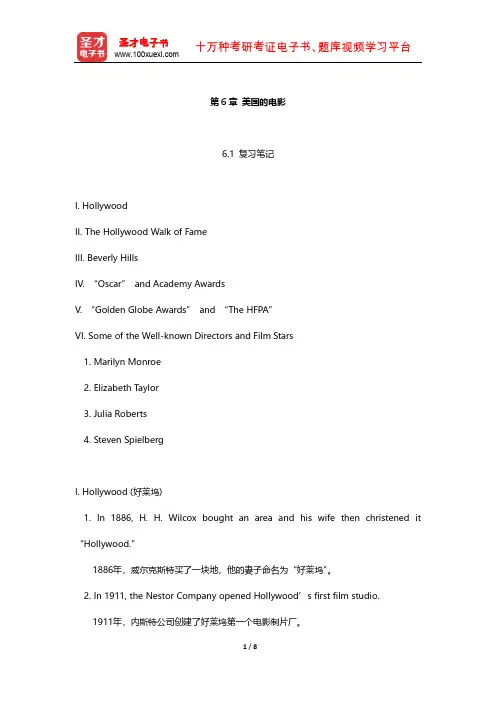
第6章美国的电影6.1 复习笔记I. HollywoodII. The Hollywood Walk of FameIII. Beverly HillsIV. “Oscar”and Academy AwardsV. “Golden Globe Awards”and “The HFPA”VI. Some of the Well-known Directors and Film Stars1. Marilyn Monroe2. Elizabeth T aylor3. Julia Roberts4. Steven SpielbergI. Hollywood (好莱坞)1. In 1886, H. H. Wilcox bought an area and his wife then christened it “Hollywood.”1886年,威尔克斯特买了一块地,他的妻子命名为“好莱坞”。
2. In 1911, the Nestor Company opened Hollywood’s first film studio.1911年,内斯特公司创建了好莱坞第一个电影制片厂。
3. In 1985, the Hollywood Boulevard commercial and entertainment district was officially listed in the National Register of Historic Places.1985年,好莱坞星光大道正式列为国家历史名胜。
4. Many best known American films have been produced in Hollywood: Gone with the Wind (1940), The Sound of Music (1966), The Godfather (1974), etc.很多著名的美国电影都是好莱坞制作的,包括《飘》(1940),《音乐之声》(1966)和《教父》(1974)等等。

第3章经济3.1 复习笔记I. The Characteristics of the British EconomyII. IndustryIII. AgricultureIV. Trade and Finance1. Trade2. FinanceI. The Characteristics of the British Economy(英国国家经济的特点)1. Britain is one of the world’s most advanced manufacturing and trading nations.2. British agriculture does not produce enough food to meet the country’s basic needs.3. British industry is operated by many different types of firms.4. The British labor force is remarkably homogeneous.1. 英国是世界上最发达的制造业和贸易国家。
2. 英国的农业满足不了国家的基本需求。
3. 英国的工业由很多不同类型的公司操纵。
4. 英国的劳动力是同质的。
II. Industry(工业)1. Most of the industries were concentrated in specialized industrial areas: cotton in eastern Lancashire; wool in the West Riding of Yorkshire; linen in Northern Ireland: ship building on the Clyde, the northeast coast, and Northern Ireland; and iron and steel and chemicals in the north, the Midlands, and South Wales.2. Machine industries were more widely distributed. The specialized manufacturing regions were also the chief coal-mining districts.1. 英国工业较为集中在一些特殊地区:兰开郡东部的棉花区,约克郡西莱丁的羊毛区,北爱尔兰的亚麻区,克莱德河上、东北海岸和北爱尔兰的造船区、英国北部、中部和威尔士南部的钢铁和化学区。
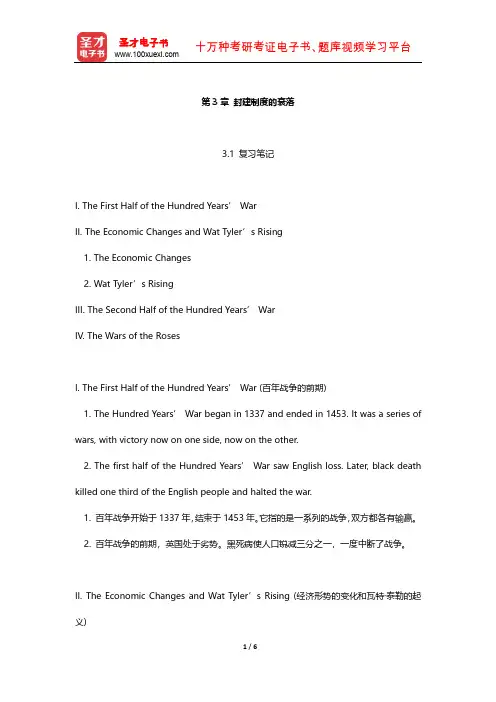
第3章封建制度的衰落3.1 复习笔记I. The First Half of the Hundred Years’ WarII. The Economic Changes and Wat Tyler’s Rising1. The Economic Changes2. Wat Tyler’s RisingIII. The Second Half of the Hundred Years’ WarIV. The Wars of the RosesI. The First Half of the Hundred Years’ War (百年战争的前期)1. T he Hundred Years’ War began in 1337 and ended in 1453. It was a series of wars, with victory now on one side, now on the other.2. T he first half of the Hundred Years’ War saw English loss. Later, black death killed one third of the English people and halted the war.1. 百年战争开始于1337年,结束于1453年。
它指的是一系列的战争,双方都各有输赢。
2. 百年战争的前期,英国处于劣势。
黑死病使人口锐减三分之一,一度中断了战争。
II. The Economic Changes and Wat Tyler’s Rising (经济形势的变化和瓦特·泰勒的起义)1. The Economic Changes (经济形势的变化)(1) Feudalism in England began to decline in the nearly 14th.(2) The vigorous economic progress of the 13th-century petered out early in the 14th century. A natural economy gradually gave way to a money economy.(3) The shortage of labor caused by the Black Death gave a chance for agricultural laborers in villages.(1) 14世纪早期,英国的封建制度开始衰落。
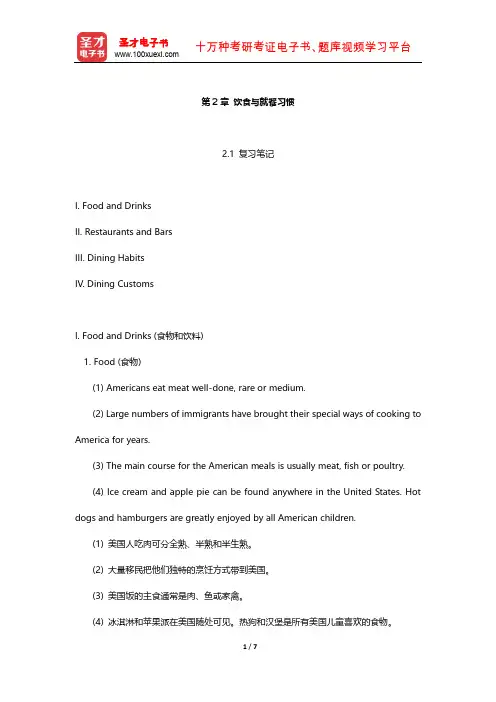
第2章饮食与就餐习惯2.1 复习笔记I. Food and DrinksII. Restaurants and BarsIII. Dining HabitsIV. Dining CustomsI. Food and Drinks (食物和饮料)1. Food (食物)(1) Americans eat meat well-done, rare or medium.(2) Large numbers of immigrants have brought their special ways of cooking to America for years.(3) The main course for the American meals is usually meat, fish or poultry.(4) Ice cream and apple pie can be found anywhere in the United States. Hot dogs and hamburgers are greatly enjoyed by all American children.(1) 美国人吃肉可分全熟、半熟和半生熟。
(2) 大量移民把他们独特的烹饪方式带到美国。
(3) 美国饭的主食通常是肉、鱼或家禽。
(4) 冰淇淋和苹果派在美国随处可见。
热狗和汉堡是所有美国儿童喜欢的食物。
2. Drinks (饮料)(1) Coffee and tea are two of the most popular hot drinks.(2) In the United States many people prefer to drink their coffee “black”without cream or sugar.(3) Sometimes “coffee break”is taken among the workers in the middle of the morning or afternoon.(4) There are some other drinks in America which are also popular, such as milk and milk drinks called milkshakes, and fruit juices etc.(1) 咖啡和茶是最受欢迎的热饮料。

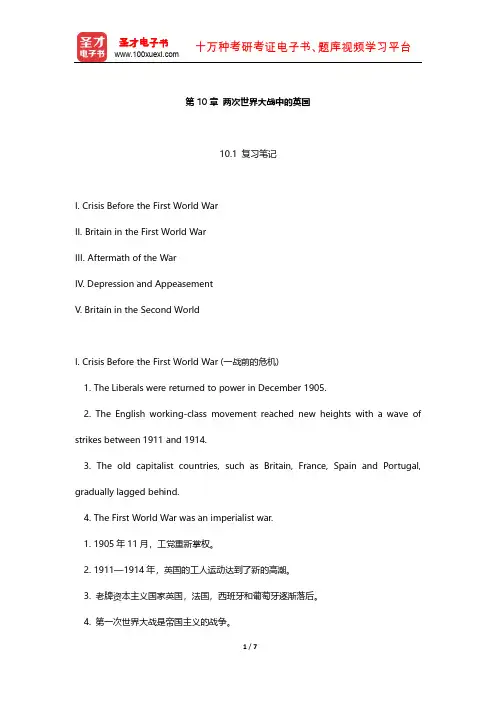
第10章两次世界大战中的英国10.1 复习笔记I. Crisis Before the First World WarII. Britain in the First World WarIII. Aftermath of the WarIV. Depression and AppeasementV. Britain in the Second WorldI. Crisis Before the First World War (一战前的危机)1. The Liberals were returned to power in December 1905.2. The English working-class movement reached new heights with a wave of strikes between 1911 and 1914.3. The old capitalist countries, such as Britain, France, Spain and Portugal, gradually lagged behind.4. The First World War was an imperialist war.1. 1905年11月,工党重新掌权。
2. 1911—1914年,英国的工人运动达到了新的高潮。
3. 老牌资本主义国家英国,法国,西班牙和葡萄牙逐渐落后。
4. 第一次世界大战是帝国主义的战争。
II. Britain in the First World War (一战时的英国)1. England participated in the First World War with national efforts. Millions of soldiers were dead and English people suffered a lot. Although England won the war, the powerful empire was gone.2. The Germans signed an armistice, which came into force on November 11, 1918.1. 英国倾其国力参加一战,士兵伤亡渗重,人民倍受苦难。
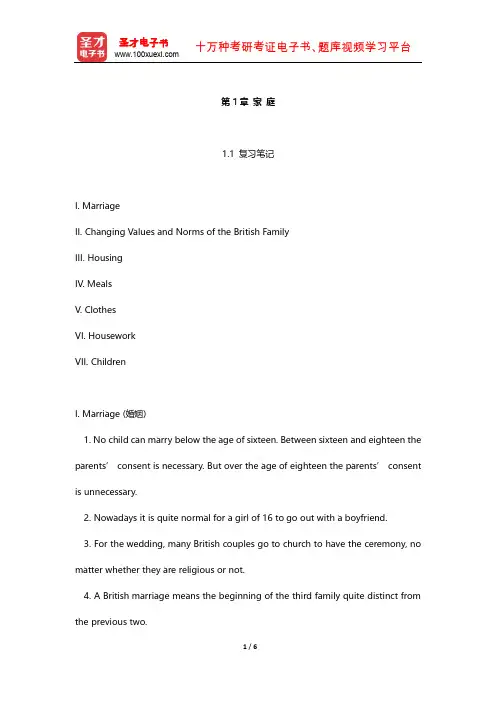
第1章家庭1.1 复习笔记I. MarriageII. Changing Values and Norms of the British FamilyIII. HousingIV. MealsV. ClothesVI. HouseworkVII. ChildrenI. Marriage (婚姻)1. No child can marry below the age of sixteen. Between sixteen and eighteen the parents’ consent is necessary. But over the age of eighteen the parents’ consent is unnecessary.2. Nowadays it is quite normal for a girl of 16 to go out with a boyfriend.3. For the wedding, many British couples go to church to have the ceremony, no matter whether they are religious or not.4. A British marriage means the beginning of the third family quite distinct from the previous two.1. 16岁以下的孩子不可以结婚。
16—18岁的孩子结婚需要征得父母的同意。
18岁以上的孩子可以不征求父母的同意。
2. 现在,16岁的女孩约会男孩,很普遍。
3. 很多英国夫妇结婚会去教堂举办仪式,不管他们是否信教。
4. 英国婚姻意味着第三家庭的形成,和之前的家庭有很大的不同。
II. Changing Values and Norms of the British Family (英国家庭变化的价值观和标准) 1. Today people’s views on marriage are changing. Many couples, mostly in their twenties or thirties, live together without getting married. About 40% of children in Britain are born to unmarried parents.2. People are generally getting married at a later age now and many women do not want to have children immediately.1. 现在,英国人的婚姻观正在改变。
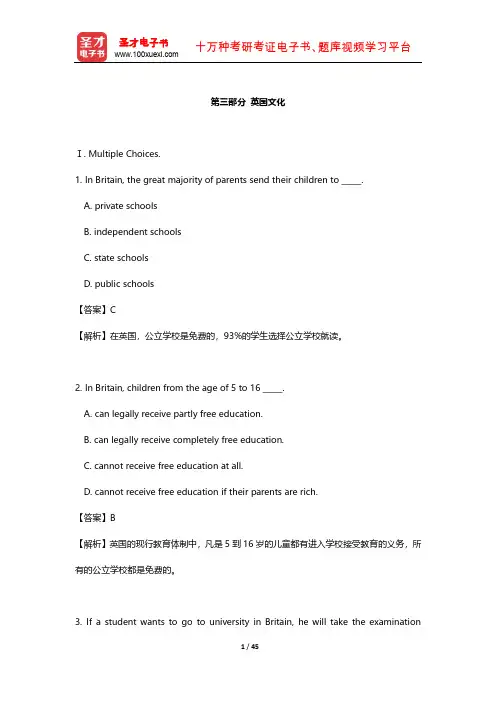
第三部分英国文化Ⅰ. Multiple Choices.1. In Britain, the great majority of parents send their children to _____.A. private schoolsB. independent schoolsC. state schoolsD. public schools【答案】C【解析】在英国,公立学校是免费的,93%的学生选择公立学校就读。
2. In Britain, children from the age of 5 to 16 _____.A. can legally receive partly free education.B. can legally receive completely free education.C. cannot receive free education at all.D. cannot receive free education if their parents are rich.【答案】B【解析】英国的现行教育体制中,凡是5到16岁的儿童都有进入学校接受教育的义务,所有的公立学校都是免费的。
3. If a student wants to go to university in Britain, he will take the examinationcalled _____.A. General Certificate of Education - Advanced.B. General Certificate of Secondary Education.C. the common entrance examination.D. General National Vocational Qualifications.【答案】A【解析】高级水平测试结业证书GCEA(General Certificate of Education-Advanced)又称A-level exams,中学毕业证书考试结束后,希望继续接受大学教育的学生会进入第六年的中学学习,然后再两年后参加A-level考试。
第7章名胜古迹7.1 复习笔记I. Westminster1. Location and area2. Features3. SignificanceII. The British Museum1. Location and constituents2. Builder3. FeaturesIII. Hyde Park1. Location and area2. Origin3. FeaturesIV. The Tower of London1. Location and area2. FeaturesV. St. Paul’s Cathedral1. Features2. OriginVI. WhitehallVII. Buckingham PalaceVIII. Greenwich Royal ObservatoryIX. Madame Tussaud’sX. StonehengeXI. The London EyeI. Westminster (威斯敏斯特)1. Location and area (地理位置与面积)Parliament Square is bounded by Westminster Palace on the east and Westminster Abbey on the south. Westminster covers eight acres and located in the heart of London.国会广场位于威斯敏斯特宫东部,威斯敏斯特教堂南部。
占地8英亩,位于伦敦中心。
2. Features (特点)(1) The palace surprises visitors by the building’s appearance of antiquity. The most popularly symbolic part of the Houses of Parliament is the 315 foot Clock Tower, famous for housing the largest and most “authoritative” clock in the world and for its 13-ton bell, called “Big Ben”.(2) It is the largest Gothic edifice in England.(3) Across Parliament Square stands St. Margaret’s, a 15th-century churchwith the finest stained-glass window in the country and Westminster Abbey. This is where sightseeing in London begins for most travelers. Its principal architectural features are the transepts with aisles;(1) 宫殿因其古老的外表吸引游客。
第4章政党和选举4.1 复习笔记I. Parties and the two-party system1. The development of two-party system2. The Conservative Party3. The Labour Party4. The Social Democratic Party5. The Liberal Party6. The Communist PartyII. ElectionI. Parties and the two-party system (政党及两党制度)1. The development of two-party system (两党制的发展)(1) The division into two parties grew out of the establishment of a Protestant Church of England in the 16th century.(2)The non-Puritan Anglicans were on the side of the King and Church, which were later called “Tories”, the Puritans were for Parliament and trade, which later refers to “Whigs”. In the 17th century the two-party system began.(3) The Tories did not appear on the political scene until 1760. The Tories andthe Whigs were alternately in power for a long time.(4) In 1860s the Whigs became Liberals. From that time the Liberals and the Conservatives were alternately in office until 1922.(5) The Labour Party was formed by the trade unions, the Independent Labour Party and the Fabian Society in 1900.(6) After 1922 the Labour Party gradually replaced the Liberal Party to become one of the two major parties in Great Britain. Now the two parties(Conservative and Labour) are regularly in power by turns.(1) 两党制的发展始于16世纪的新教国教的建立。
张奎武《英美概况》笔记及习题(家庭)【圣才出品】第1章家庭1.1 复习笔记I. ImmigrantsII. Nucleus familyIII. Marriage and dateIV. IndependenceV. Situation of senior citizensVI. The position of womenVII. Difference between black and whiteI. Immigrants (移民)1. America has the most immigrants in the world. Of the population of 300 million, more than 16 percent were born in other countries or are the children of at least one foreign born parent.美国有世界上最多的移民。
在3亿⼈⼝中,16%的⼈来⾃其他国家或⽗母有⼀⽅来⾃外国。
2. They have different social customs and personal habits.他们有不同的社会风俗和个⼈习惯。
II. Nucleus family (核⼼家庭)In America, a family is usually composed of a father, mother and two children. The family usually lives independently without elders and relatives.在美国,⼀个家庭通常由⽗母和两个孩⼦组成。
家庭单独⽣活,不与⽼⼈和亲戚⼀起住。
III. Marriage and date (婚姻与约会)1. Young people have their own right to deal with their marriages and are independent of their parents.年轻⼈有权决定婚姻,⽗母不⼲涉。
英美概况根据高职教育的培养目标,《英美概况》体现了“实用性第一、充分性为程度”的英语教学理念。
它是从比较的角度编写的,便于学生学习和掌握。
全书分为十个单元,包括英美历史、地理、政治、经济、文化、教育和社会生活的基础知识。
本教材可作为高职院校、高等院校和成人教育院校三、两年制英语专业的教材,也可作为自学学者和英语爱好者的自学教材。
书籍信息作者:张奎武主编ISBN:10位[7538401377]13位[9787538401370]出版社:吉林科学技术出版社出版日期:2004-7-1定价:¥32.00 元2内容提要在编写过程中还注意到以下几条原则:1、以事实为基础,介绍关背景知识,对重要事件、人物等以马克思主义观点进行扼要的分析的评论。
2、尽可能多地收入对英语学习有益的背景知识,并保证教学大纲所规定的重点。
3、英文力求浅显易懂得,便于阅读。
4、编写中文提要,编制表格和附录,为读者提供自学方便,使之“无师自通”。
本书分上、下两册,上册是《英国概况》,下册是《美国概况》。
每册分五编:地理、历史、文化、社会生活、政治制度与政党。
每编之首有中文提要,简要介绍本编的主要内容。
每编分若干章,每章末尾有习题,习题分回答问题和解释名词两种。
中文提要与习题所涉及的内容是读者应掌握的重点。
书后有附录。
3目录BREITAINPART ONE GEOGRAPHYPART TWO HISTORYPART THREE CULTUREPART FOUR SOCIAL LIFEPART FIVE POLITICAL SYSTEMAppendix 1 The Counties of the United Kingdom of Great Britain and Northem IrelandAppendix 2 English and British MonarchsAppendix 3 Prime Ministers of Great BritainAMERICAPART ONE GEOGRAPHYPART TWO HISTORYPART THREE CULTUREPART FOUR SOCIAL LIFEPART FIVE POLITICAL SYSTEMAppendix 1 The 50 States of U.S.A.Appendix 2 The Presidents of U.S.A.Appendix 3 Chronological Table of the Major Events in American HistoryCANADA,AUSTRALIA AND NEW ZEALAND4文摘There are many other religious denominations in Britain besides the Church ofEngland and the Nonconformist Churches.There are about 450,000 Jews in Europe. More than half of them live in Lon-don. Jews still tend to marry Jews, for both racial and religious reasons. But amongthe young generation this is happening less and less.The leader of the Roman Catholic Church in Britain is the Cardinal Archbishop ofWestminster. The United Kingdom is divided into eight Catholic provinces, four inEngland, two in Scotland, and one each in Wales and Northern Ireland. Each prov-ince is controlled by an archbishop and is divided into dioceses, each of which isheaded by a bishop.The Churches in Scotland are almost in every respect similar to the Low Churchsection of the Anglican Church. They have a similar kind of service and share thesame apostolic succession(the passing on through bishops and priests of the powersand mission that was handed by Christ to his apostles). The Churches in Wales are Calvinist or Presbyterian. This type of church is ofpurely Welsh origin, drawing its members from a large section of the Welsh-speakingpopulation. It is not an established church, but it is a member of the British Councilof Churches. The Calvinist Church is the Sunday school; adults as well as children goto the church to study the Bible. In England and Scotland only children attend suchschools.There are five main features of the British worship: unity among the churches,social responsibility, the keeping-up with the time, no "Christian" political party anda widespread interest in religion.Religion is playing an increasingly less important role in the social life of Britain.It is of much significance in literature and art, in social life and in Western civiliza-tion.5序言随着高职教育在我国的大力普及和推广,高职英语教学也越来越受到重视,高职英语教育的改革力度日益加大,并取得了很大成绩,特别是优秀的高职英语教材层出不穷。
第4章处世态度4.1 复习笔记I. American Social RelationsII. The American Spirit of “Do-It-Yourself”III. A Popular American BeliefI. American Social Relations (美国社会关系)1. America is characterized by much more informality and less social distinction than many other countries.2. Americans care a great deal about equality and they generally do not like to be considered inferior.3. Americans will be pleased when their accomplishments are talked about, but they seem to be accustomed to showing certain modesty in answer to them.4. Social conventions in America are becoming fewer and fewer nowadays. But still America is a country with certain customs that show consciousness of social distinction.5. Clothing in America reflects, to a certain degree, a person’s social position and income, and especially attitudes of the young people towards the society and towards themselves.6. Customs by which a man shows respect for a woman are still popular in America.7. The frankness of admitting certain weaknesses is another characteristic of the American people.1. 美国以不拘礼节,比其他国家较少的社会差异著称。
第1章加拿大1.1 复习笔记I. Geography1. Introduction2. Eight Geographical Divisions3. Five Economic and Cultural Regions4. ClimateII. HistoryIII. Economy1. Introduction2. Agriculture3. Industry4. Canada-U.S. Economic Relations5. New DevelopmentsIV. Political System1. Federal Government (Central Government)2. Political Parties and Elections3. Provincial GovernmentV. Society and Culture1. Education2. Literature3. Sports and Recreation4. Transportation and CommunicationI. Geography (地理)1. Introduction (介绍)(1) Canada is located on the North American Continent and occupies nearly all of it. It is on the north of the United States.(2) Canada is the second largest country in the world in land area.(3) The country includes ten provinces and two territories.(1) 加拿大位于北美大陆,约占北美大陆的二分之一,南部与美国接壤。
(2) 加拿大是世界上陆地面积第二大国家。
(3) 加拿大包括十个省和两个地区。
2. Eight Geographical Divisions (八大地形区)Canada can be divided into eight parts according to its geographical features.(1) Appalachian Highlands are part of the Appalachian Mountains. They are made up mainly of hills and low mountains.(2) St. Lawrence-Great Lakes Lowland is made up of fertile farmlands. More than 60 percent of the Canada people live there.(3) Canadian Shield is an area of rock with moss covered and treeless plains inthe north as well as thick forests to the south.(4) Between the Canadian Shield and Hudson Bay, is the Hudson Bay Lowland.(5) Interior Plains is part of the Great Plains, which occupy most part of the central United States.(6) Rocky Mountains are on the west of the Interior Plains.(7) Pacific Mountain and Valley System include the Coast Mountains.(8) Arctic Island includes about ten big island and hundreds of small ones.根据加拿大的地理特征,全国可分为八大地区。
(1) 阿巴拉契亚高原地区是阿巴拉契亚山的一部分,主要由高山和低山组成。
(2) 圣劳伦斯河低地由肥沃的农田组成。
60%多的加拿大人居住在这里。
(3) 加拿大地盾由布满苔藓的岩石组成,北部是荒原,南部是森林。
(4) 加拿大地盾和哈得逊湾之间是哈得逊湾低地。
(5) 内部平原是大平原的一部分,大平原占据了美国中部一半的面积。
(6) 落基山脉在内部平原的西部。
(7) 太平洋山系和山谷包括海岸山脉。
(8) 北极岛包括十个大岛和上百个小岛。
3. Five Economic and Cultural Regions (五个经济文化区)Canadian territories are divided into five regions according to their different economic and cultural characteristics.根据不同地区独特的经济和文化特点,加拿大可分为五大地区。
(1) Atlantic Provinces (大西洋诸省)①Shipping and fishing have long been important activities in the region.②The Grand Banks is one of the world’s best fishing areas.①这一地区的轮船和渔业是重要产业。
②大浅滩是世界上最好的渔区。
(2) Great Lakes-St. Lawrence Provinces (五大湖—圣劳伦斯湖诸省)①This region is the economic and political center of the whole country.②About 60 percent of the population lives there.①这一地区是全国的经济和政治中心。
②60%的加拿大人居住在这一地区。
(3) Prairie Provinces (草原诸省)The region is lightly populated and the northern parts of the region are mostly unsettled because of harsh climate.这一地区人口较少,北部地区因为天气恶劣无人居住。
(4) British Columbia (不列颠哥伦比亚省)①It is an area of mountains, dry-land plateaus and fertile river valleys.②Vancouver, the capital of Canada, is the most important and busiest harbor on the pacific coast of North America. The city is also a major financial center.①这一地区多山,高原干地和富饶的河流峡谷。
②温哥华是加拿大的首都,也是北美洲最重要和最繁忙的太平洋海岸港口,同时还是主要的金融中心。
(5) Canadian T erritories (加拿大领土)Generally speaking, the territories still remain mostly undeveloped.一般而言,这一地区还未开发。
4. Climate (气候)Canada has a continental climate. It is arctic in the north and maritime near the west coast, while near the U.S. border a narrow strip, it has a temperate climate with cold winters.加拿大属于大陆性气候。
北部非常寒冷,西海岸偏海洋性气候,而靠近北国边界的狭长地带,属于温带气候,冬天寒冷。
II. History (历史)1. John Cabot, an Italian explorer, discovered Canada in 1497.2. According to the Treaty of Paris (1763), the British allowed the French colonists to stay on the territory controlled by the British.3. Quebec is the French gathering province under the British Governors’control.4. There were two major events in the history of Canada foundation. The first one was the building of Canadian Pacific Railway. The second big event was Louis Riel’s execution after 1885. After the two events, Canada experienced hard times.5. The Statute of Westminster of 1931 recognized Canada as an equal member of the Commonwealth to Britain.6. Canada experienced economic depression of1930s. Until World War II, Canada was able to recover from the depression.7. After World War II, the long-standing problem of French-Canadian relationshipto the nation became fiercer.8. Key to the national unity debate is the ongoing issue of Quebec separation. In 1987, the Meech Lake Accord, a compromise agreement recognized Quebec as a “distinct society”.1. 约翰·卡波特,一位意大利探险家,于1497年发现了加拿大。